
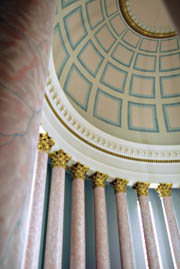
"I've got five ornamental crews and six plaster crews working nearly 'round the clock," says Inmon, plastering superintendent at D.L. Henricksen Co. Inc., of Tacoma, Wash. "But this is the chance of a lifetime. It's fantastic to be working on this project." Jim Inmon was fresh out of high school when he first worked on the Washington State Capitol Complex-shortly after the 1965 earthquake in the area. Two Capitol renovations, one earthquake and 39 years later, Inmon is back in Olympia, leading plasterers in the rehabilitation of the state's most significant and historic structure. Washington officials have high expectations for the 1928 legislative building and Inmon is eager to please.
"I've got five ornamental crews and six plaster crews working nearly 'round the clock," says Inmon, plastering superintendent at D.L. Henricksen Co. Inc., of Tacoma, Wash. "But this is the chance of a lifetime. It's fantastic to be working on this project."
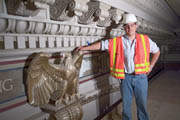
Historical high hopes
D.L. Henricksen has the $6.5 million plaster contract for the $118 million renovation of the Washington State Legislative Building.Prompted by a 2001 earthquake and a need to modernize, the Capitol project, strictly speaking, is "a rehabilitation." Repairs and upgrades are being completed in accord with the Secretary of the Interior's "Standards for Rehabilitation and Guidelines for Rehabilitating Historic Buildings." The state of Washington commissioned a "historic structure report" from a private consulting firm and included on the architectural team Einhorn Yaffee Prescott Architecture & Engineering P.C., an Albany, N.Y., firm specializing in historic rehabilitations.
It all means that Inmon and D.L. Henricksen crews must blend plastering patches seamlessly with the original walls. That's proving to be no easy feat, since the original plasterwork says Inmon "has 100 different grades of sand that we're trying to match."
Furthermore, detailed ornamental cornices must be fabricated the old-fashioned way-molded on site with casting and pottery plaster, and fastened to walls using hemp ties. Strict historic guidelines even require that materials no longer used-lime plaster with horse hair, for example-be worked as they were in 1922 when construction of the legislative building began.
"We're keeping the historical perspective of the building intact by using traditional materials and substituting modern materials when they provide a specific benefit," says Mark Fowler, architectural consultant of the Northwest Wall and Ceiling Bureau. "The lime putty they brought in says on the bucket, ‘For the repair of historic masonry buildings-pre-1872.' Now that's getting ‘historical.'"
The work of Fowler and NWCB's Executive Director Robert Drury has been invaluable. With a mix of both old and new plaster systems already in place, the bureau's experts helped identify existing systems and substrates and write submittals and procedures.
"They've been on the project since day one, even back as far as the (2001) earthquake days," says Steve Henricksen, chief operations officer, of D.L. Henricksen. "We know our trade well but they give reassurance to the owners by providing technical information that matches what we tell them."
Members of U. S. Gypsum's Architectural Services team traveled to the site, analyzed existing systems, made recommendations and submitted specifications input even before landing the project.
"The technical issues on this job are immense," says Kevin Moyer, USG's plaster business manager. "The building has been through several earthquakes and several additions, changes and modifications throughout its history, so blending the plasterwork seamlessly is a challenge."
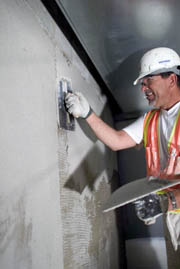
Tight timeframe
The expectations would also have to be met quickly. Legislators will return to the Capitol for a January 2005 session.D.L. Henricksen began its ornamental work in September of 2003 and the full-scale plastering commenced this past January. To date, D.L. Henricksen crews have completed the interior of the Capitol's dome, the main legislative chambers, the governor's offices and the lieutenant governor's offices. The final veneer plastering on various first-floor suspended ceilings-being lowered a few inches before adding back cornices-was completed in August. Project completion was scheduled for the end of October, with owner move-in targeted for early November.
To meet the deadlines, Inmon ran his lathers, plasterers and laborers-approximately 40 persons total-at breakneck speed: five 10-hour days, plus an eight-hour Saturday. In total, D.L. Henricksen crews applied more than 100,000 square feet of plaster and at least 7,000 lineal feet of decorative plaster ornamentation.
"The original plaster is anywhere from 3/4 to 11⁄2 inches thick, depending on how straight the walls were when they were originally put up," says Paul Cochran, vice president of supplier Salmon Bay Sand & Gravel Co. Inc., Seattle. "There really is no way of gauging how much material is going to be used because there's so much square footage-and all of it has varying thicknesses."
With so much unknown, and expectations running high, how in the world did D.L. Henricksen ever calculate a bid that allowed for making money? The answer: experience.
The company, in business since 1948, worked on a Capitol complex renovation in the '70s. That was the last time the Legislative Building received a seismic upgrade. Henricksen's father was alive at the time, and his brother Rocky also worked on the '70s renovation.
"The historic data from that job," says Henricksen, "was a big factor in our winning the contract."
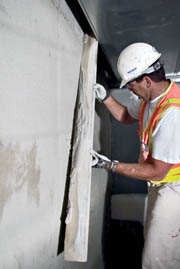
Help from suppliers
Salmon Bay Sand & Gravel played a key role, too. The company has been innovative in managing materials. Hampered by the site's tight staging quarters and extra security, Salmon Bay sent a truck to the site two and sometimes three times a week. But being based in Seattle, the company had to spot some material closer to the job to make it work.According to Cochran, Salmon Bay struck a deal with the project's sand supplier, Basalite, of Du Pont, Wash., to use its yard as a sourcing location. Cochran says nearly half of the material Salmon Bay delivered to the Capitol Complex came from its inventories in the Basalite yard. This enabled Salmon Bay to service the job more responsively than it could have done from Seattle. That aided D.L. Henricksen's workflow significantly.
Furthermore, Salmon Bay purchased a $4,000 electric pallet jack, which it kept on the job site. A Salmon Bay warehouse hand, who traveled along with the driver of each shipment, used the pallet jack to move material into the Legislative Building's ground floor. From there, D.L. Henricksen laborers took over, staging the material throughout the building. Since the building structure will only allow 150 pounds per square foot of material to be stored in any one area, material must be moved methodically a few bags and buckets at a time.
While cognizant of the strict historical requirements mandated for their work, D.L. Henricksen crew members are also well aware of their moment in history.
"We've worked on a project that will be here for another 75 years," says Inmon. "Our work will be here for our grandchildren to see."
Moyer believes the Washington State Capitol project was the largest plaster job underway in the country in 2004. Inmon estimates his crews used more than 8,000 sacks of plaster on the job. But nobody's complaining.
"It's probably the happiest group I've had in years," says Henricksen. "The guys are just loving it-they're proud of what they're doing."
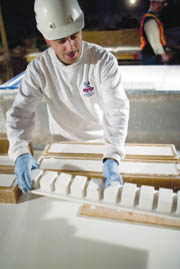
Sidebar: The Ornamental Molding Shop
D.L. Henricksen set up its ornamental plaster molding shop in the Columbia Room on the ground floor of the Legislative Building. There, in a 70-foot-by-70-foot octagon-shaped space, the firm stored materials and mixed plasters alongside "mold man" Marco D. Mandoli, an Italian craftsman trained in the art of European plaster ornamentation."You'd think he's a dentist," says the NWCB's Mark Fowler. "He has so many tools."
Plaster Superintendant Jim Inmon, himself an ornamental plasterer, describes the mold shop as part art studio, part woodworking shop. The shop used four plywood platforms, eight mold boxes and 10 profile templates, and generated its creations using USG's Casting Plaster and No.1 Pottery Plaster. Most of the "splash" impressions of "flower," "leaf" and other ornamental details were taken right off existing walls using a rubberized casting system. Five brothers from Mexico, experts in running plaster cornices with speed, secured the final moldings.
Says Inmon: "You don't find plastering projects requiring this much material and this many experts every day."

Report Abusive Comment